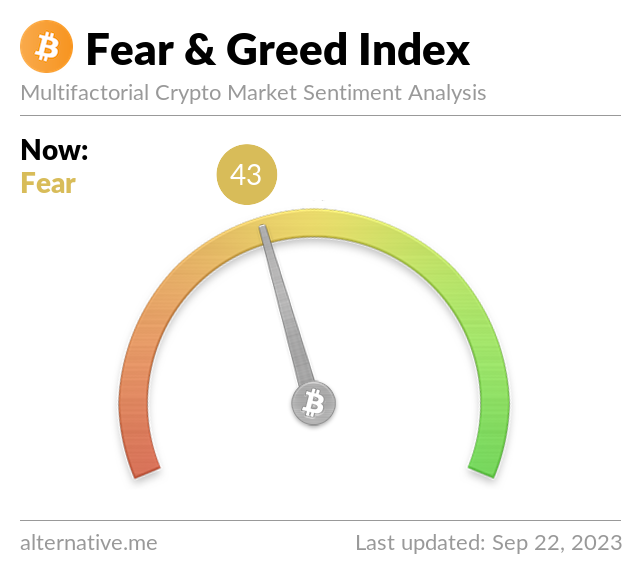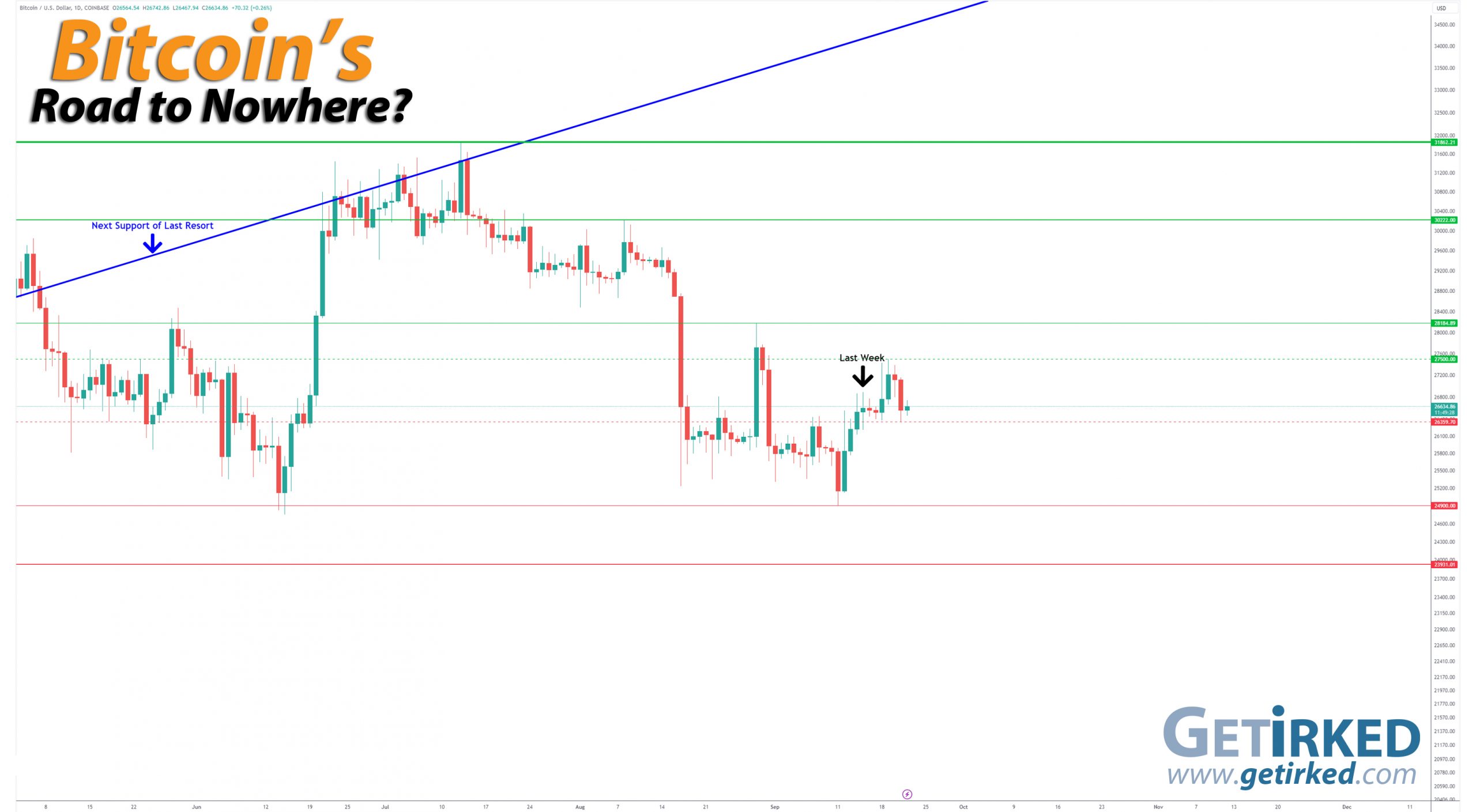Summing Up The Week
Slowly at first, then all at once…
Weeks with Federal Reserve meetings tend to be incredibly dull up until the Wednesday announcement of the Fed decision and this week was no different.
This kind of slow price action makes sense intuitively: since every market participant knows the Fed will likely be a market-moving event, why make any moves ahead of that catalyst? Unfortunately for market nerds like myself, it makes for a boring couple of days, of course.
However, after the markets seemed to take notice of Powell’s comments, things got a lot more exciting after Wednesday’s press conference.
Let’s take a look at the news that moved the markets…
Market News
Fed Meeting! Nothing new: No hike, but higher for longer
Federal Reserve policy has become a lot like the movie Groundhog Day where Bill Murray experiences the same day on repeat. On Wednesday, the Fed paused its rate hike cycle, but reiterated there will be at least one more hike in 2023 and that rates will stay high throughout 2024, reported CNBC.
One subtle change on the dot plots – the plots that show where the voting Fed governors believe rates will be in the future – showed that the FOMC expects the rate to be 3.9% in 2025, an increase of 0.5% from 3.4% at the last meeting.
With 2.9% considered a “neutral” interest rate, the FOMC plans to keep rates restrictive for at least the next 12-18 months in order to ensure inflation is fully under control.
Government Shutdown looms with little progress
On Thursday, House Speaker Kevin McCarthy continued to struggle trying to pull his Republican caucus together in time avoid a government shutdown set to begin October 1, reported CNBC. The situation appears dire for McCarthy, whose own party is divided between avoiding the shutdown however possible and demanding a more balanced budget.
“We want to avoid this shutdown however we can,” Oklahoma GOP Sen. Markwayne Mullin told CNBC Thursday. “McCarthy is trying to work with his members to get the most conservative bill that they can pass, that can also be passed in the Senate.”
However, even if McCarthy can get the House to pass a bill, the likelihood the Senate would pass the same bill seems slim. Democrats expressed their frustration over the lack of cooperation from the GOP. “The House Republican majority has tried everything but working with Dems in the House,” Delaware Democratic Sen. Chris Coons told CNBC Thursday.
Later on Thursday, the Republican leaders sent the chamber into recess when a procedural bill on a defense funding bill failed. This recess likely means no deal will be reached before the deadline.
While only a temporary catalyst, a government shutdown would most certainly apply significant selling pressure to the stock market. Pile that pressure on with the already weakening markets thanks to seasonal profit-taking, and we could see a recipe brewing for a more painful pullback in stocks.
B of J leaves rates unchanged, “extremely high uncertainties”
On Thursday, the Bank of Japan announced it would maintain short-term interest rates at -0.10%, a decision which caused the Japanese yen to continue to sink 0.5% in value against the U.S. dollar, reported CNBC.
“With extremely high uncertainties surrounding economies and financial markets at home and abroad, the Bank will patiently continue with monetary easing, while nimbly responding to developments in economic activity and prices as well as financial conditions,” the Bank of Japan said in a statement Friday.
Unfortunately, this extremely loose monetary policy and resulting devaluing of the yen is not a good thing for Japan or the United States. If the yen devalues too much, the Bank of Japan may have to “defend” the yen by selling U.S. treasuries, flooding supply, and subsequently causing the equity market to sell off significantly.
Next Week’s Gameplan
With a potential government shutdown looming and the seasonal profit-taking by hedge funds and institutions, we have officially entered Buying Season.
Remember: As long term investors, we do not fear systemic selloffs. With a long time horizon, systemic selloffs should be viewed as “Black Friday sales” and buying opportunities.
While no selloff feels good while it’s happening, long term investors should make buying plans for each of their positions well in advance. In my case, I actually place the next 2-3 buy orders as limit orders for each of my positions.
This helps me in two ways:
- If I’m working, I don’t need to check the markets to ensure my buys are taking place if my positions hit my next buy target.
- It removes emotion. By placing the limit orders in advance, if I feel overwhelmed by the negative movement in the markets, I stop looking at it. I’ve learned to trust the work I performed when I was objective and unemotional. I never let a dramatic selloff sway me from my plan.
With that, remember to keep calm and keep investing on. I’ll see you all back here next Friday!
This Week in Play
Stay tuned for this week’s episodes of my two portfolios Investments in Play and Speculation in Play coming online later this weekend!
Crytpo Corner

Bitcoin Price (in USD)
%
Weekly Change
Bitcoin Price Action
Investors sell what they can, not what they want to…
Many Bitcoin maximalists continue to extol the “Bitcoin is a store of wealth” narrative, arguing that HODLers won’t sell into a systemic market selloff in the stock market. So far, that narrative has been disproven over and over again.
Instead, the old trading/investing adage holds true: when the entire market is selling off, people will sell anything they can get their hands on. This means that Bitcoin, and, yes, even gold, sell off during a systemic market selloff.
In fact, the only asset that has been proven to be 100% reliably “safe” over and over again remains cold, hard cash. Nothing makes investors feel more secure than converting their assets into cash.
And that’s what happened to Bitcoin this week as the selloff reversed the crypto’s rally after making a new weekly high at $27,500.00 on Tuesday. Bitcoin’s reversal did set a new weekly low at $26,359.70 on Thursday.
If Bitcoin breaks its new low, the next key level of support is its monthly low at $24,900.00, followed by $23,931.01 from quite some time ago.
The Bullish Case
Bulls did see a bit of relief this week as Bitcoin made a new weekly high, however the crypto remains quite a distance off its monthly high $28,184.89 set in August, making Bitcoin very firmly in a downward trend. However, the Bulls remain optimistic, claiming that Blackrock is surely accumulating more of crypto in preparation for its upcoming ETF.
The Bearish Case
Bears rejoiced when Bitcoin sold off with the rest of the markets on Wednesday and Thursday, once again proving that Bitcoin remains a risk asset, just like any other tech-related equity. The Bear thesis is that Bitcoin still holds its downward trend and will likely break lower if the rest of the stock market continues to sell off. And, given the season tendency for equities to sell off, it’s hard to argue this narrative.
Bitcoin Trade Update
Current Allocation: 2.033% (+0.033% since last update)
Current Per-Coin Price: $27,695.78 (-$14.98 since last update)
Current Profit/Loss Status: -3.83% (+0.69% since last update)
I was only able to make one buy this week at $26,508.02 (before fees). The buy lowered my per-coin a miniscule cost -$14.98 from $27,710.76 down to $27,695.78 and raised my allocation an equally tiny +0.033% from 2.000% to 2.033%.
Accordingly, I’ve gotten more aggressive with my buying price targets while maintaining low buy quantities should we see a more significant selloff in Bitcoin in the coming days.
Bitcoin Buying Targets
Using Moving Averages and supporting trend-lines as guides, here is my plan for my next ten (10) buying quantities and prices:
0.027% @ $26,186
0.027% @ $25,847
0.027% @ $25,516
0.027% @ $25,309
0.027% @ $25,013
0.027% @ $24,771
0.027% @ $24,536
0.027% @ $24,233
0.027% @ $23,377
0.038% @ $23,087
Not Your Keys, Not Your Crypto…
In light of brokerage failures in 2022, I no longer keep any of my crypto on an exchange and I only keep enough USD on the exchanges I use to execute my next few buys. I use multiple cold wallets from the brands Ledger and Trezor to hold my crypto (click the links to access the direct sites, and I receive no affiliate benefits from these links).
Additionally, I have now divided my allocated USD between two different exchanges – Gemini and Coinbase – in case one (or both) becomes insolvent. Disclaimer: We both receive a bonus if you use either my Gemini or Coinbase referral links to open accounts.
I do not trust anyone in the space, even with Coinbase (COIN) being publicly traded (and one of my own Investments in Play positions).
No price target is unrealistic in the cryptocurrency space – Bullish or Bearish.
While traditional stock market investors and traders may think the price targets in the cryptocurrency space are outlandish due to the incredible spread (possible moves include drops of -90% or more and gains of +1000% or more), Bitcoin has demonstrated that, more than any speculative asset, its price is capable of doing anything.
Here are some of Bitcoin’s price movements over the past couple of years:
- In 2017, Bitcoin rose +2,707% from its January low of $734.64 to make an all-time high of $19,891.99 in December.
- Then, Bitcoin crashed nearly -85% from its high to a December 2018 low of $3128.89.
- In the first half of 2019, Bitcoin rallied +343% to $13,868.44.
- In December, Bitcoin crashed -54% to a low of $6430.00 in December 2019.
- In February 2020, Bitcoin rallied +64% to $10,522.51.
- In March , Bitcoin crashed nearly -63% to a low of $3858.00, mostly in 24 hours.
- Then, Bitcoin rallied +988% to a new all-time high of $41,986.37 in January 2021.
- Later in January 2021, Bitcoin dropped -32% to a low of $28,732.00.
- In February, Bitcoin rallied +103% to a new all-time high of $58,367.00.
- Later in February, Bitcoin dropped -26% to a low of $43,016.00.
- In April , Bitcoin rallied +51% to a new all-time high of $64,896.75.
- In June , Bitcoin crashed -56% to a low of $28,800.00.
- In November, Bitcoin rallied +140% to a new all-time high of $69,000.00.
- In November 2022, Bitcoin crashed -78% to a low of $15,460.00.
- In April 2023, Bitcoin rallied +101% to a high of $31,050.00.
- In June, Bitcoin dropped -20% to a low of $24,750.00
- In July, Bitcoin rallied +29% to a high of $31,862.21.
- In September, Bitcoin dropped -22% to a low of $24,900.00.
Where will Bitcoin go from here? Truly, anything is possible…
What if Bitcoin’s headed to zero?
The only reason I speculate in the cryptocurrency space is I truly believe Bitcoin isn’t headed to zero.
I am prepared for that possibility, however, by knowing I could potentially lose all of the capital I’ve allocated to this speculative investment. Professional advisers recommend speculating with no more than 5% of an investor’s overall assets. Personally, I’ve allocated less than that to speculating in crypto.
I feel that anyone who doesn’t fully believe in the long-term viability of cryptocurrency would be better served not speculating in the space.
On a good day, this asset class isn’t suitable for those with weak stomachs. On volatile days, the sector can induce nausea in the most iron-willed speculator. If a speculator isn’t confident in the space, the moves will cause mistakes to be made.
DISCLAIMER: Anyone considering speculating in the crypto sector should only do so with funds they are prepared to lose completely. All interested individuals should consult a professional financial adviser to see if speculation is right for them. No Get Irked contributor is a financial professional of any kind.
Ways to give back to GetIrked:
Send me a tip via Stripe! Thank you!
Get free money by signing up for an account with my referral link for Schwab
Sign up for Gemini and we each get $10
Click this referral link to get the Brave Browser
If you use Brave, you can also use the Tip function to tip me in Basic Attention Token (BAT).
Suicide Hotline – You Are Not Alone
Studies show that economic recessions cause an increase in suicide, especially when combined with thoughts of loneliness and anxiety.
If you or someone you know are having thoughts of suicide or self-harm, please contact the National Suicide Prevention Lifeline by visiting www.suicidepreventionlifeline.org or calling 1-800-273-TALK.
The hotline is open 24 hours a day, 7 days a week.


